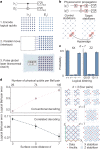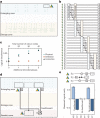Logical quantum processor based on reconfigurable atom arrays
- PMID: 38056497
- PMCID: PMC10830422
- DOI: 10.1038/s41586-023-06927-3
Logical quantum processor based on reconfigurable atom arrays
Abstract
Suppressing errors is the central challenge for useful quantum computing1, requiring quantum error correction (QEC)2-6 for large-scale processing. However, the overhead in the realization of error-corrected 'logical' qubits, in which information is encoded across many physical qubits for redundancy2-4, poses substantial challenges to large-scale logical quantum computing. Here we report the realization of a programmable quantum processor based on encoded logical qubits operating with up to 280 physical qubits. Using logical-level control and a zoned architecture in reconfigurable neutral-atom arrays7, our system combines high two-qubit gate fidelities8, arbitrary connectivity7,9, as well as fully programmable single-qubit rotations and mid-circuit readout10-15. Operating this logical processor with various types of encoding, we demonstrate improvement of a two-qubit logic gate by scaling surface-code6 distance from d = 3 to d = 7, preparation of colour-code qubits with break-even fidelities5, fault-tolerant creation of logical Greenberger-Horne-Zeilinger (GHZ) states and feedforward entanglement teleportation, as well as operation of 40 colour-code qubits. Finally, using 3D [[8,3,2]] code blocks16,17, we realize computationally complex sampling circuits18 with up to 48 logical qubits entangled with hypercube connectivity19 with 228 logical two-qubit gates and 48 logical CCZ gates20. We find that this logical encoding substantially improves algorithmic performance with error detection, outperforming physical-qubit fidelities at both cross-entropy benchmarking and quantum simulations of fast scrambling21,22. These results herald the advent of early error-corrected quantum computation and chart a path towards large-scale logical processors.
© 2023. The Author(s).
Conflict of interest statement
M.G., V.V. and M.D.L. are co-founders and shareholders and H.Z., P.S.R. and T.K. are employees of QuEra Computing.
Figures















Similar articles
-
Quantum teleportation of physical qubits into logical code spaces.Proc Natl Acad Sci U S A. 2021 Sep 7;118(36):e2026250118. doi: 10.1073/pnas.2026250118. Proc Natl Acad Sci U S A. 2021. PMID: 34479998 Free PMC article.
-
Entangling logical qubits with lattice surgery.Nature. 2021 Jan;589(7841):220-224. doi: 10.1038/s41586-020-03079-6. Epub 2021 Jan 13. Nature. 2021. PMID: 33442044
-
Superconducting quantum circuits at the surface code threshold for fault tolerance.Nature. 2014 Apr 24;508(7497):500-3. doi: 10.1038/nature13171. Nature. 2014. PMID: 24759412
-
Fault-tolerant operation of a logical qubit in a diamond quantum processor.Nature. 2022 Jun;606(7916):884-889. doi: 10.1038/s41586-022-04819-6. Epub 2022 May 5. Nature. 2022. PMID: 35512730 Free PMC article.
-
Semiconductor quantum computation.Natl Sci Rev. 2019 Jan;6(1):32-54. doi: 10.1093/nsr/nwy153. Epub 2018 Dec 22. Natl Sci Rev. 2019. PMID: 34691830 Free PMC article. Review.
Cited by
-
Entanglement and iSWAP gate between molecular qubits.Nature. 2024 Nov 13. doi: 10.1038/s41586-024-08177-3. Online ahead of print. Nature. 2024. PMID: 39537926
-
Individually addressed entangling gates in a two-dimensional ion crystal.Nat Commun. 2024 Nov 9;15(1):9710. doi: 10.1038/s41467-024-53405-z. Nat Commun. 2024. PMID: 39521764 Free PMC article.
-
Applying quantum approximate optimization to the heterogeneous vehicle routing problem.Sci Rep. 2024 Oct 25;14(1):25415. doi: 10.1038/s41598-024-76967-w. Sci Rep. 2024. PMID: 39455701 Free PMC article.
-
Creating and controlling global Greenberger-Horne-Zeilinger entanglement on quantum processors.Nat Commun. 2024 Oct 12;15(1):8823. doi: 10.1038/s41467-024-53140-5. Nat Commun. 2024. PMID: 39394188 Free PMC article.
-
Universal quantum operations and ancilla-based read-out for tweezer clocks.Nature. 2024 Oct;634(8033):321-327. doi: 10.1038/s41586-024-08005-8. Epub 2024 Oct 9. Nature. 2024. PMID: 39385054 Free PMC article.
References
-
- Preskill J. Quantum computing in the NISQ era and beyond. Quantum. 2018;2:79. doi: 10.22331/q-2018-08-06-79. - DOI
-
- Shor, P. W. in Proc. 37th Conference on Foundations of Computer Science 56–65 (IEEE, 1996).
-
- Steane A. Multiple-particle interference and quantum error correction. Proc. R. Soc. Lond. A Math. Phys. Eng. Sci. 1996;452:2551–2577. doi: 10.1098/rspa.1996.0136. - DOI
-
- Dennis E, Kitaev A, Landahl A, Preskill J. Topological quantum memory. J. Math. Phys. 2002;43:4452–4505. doi: 10.1063/1.1499754. - DOI
-
- Ryan-Anderson, C. et al. Implementing fault-tolerant entangling gates on the five-qubit code and the color code. Preprint at https://arxiv.org/abs/2208.01863 (2022).
LinkOut - more resources
Full Text Sources


